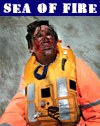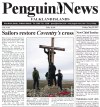|
On 25th May 1982 - Argentina's National Day - Fuerza Area Argentina (Argentine Air Force) A-4B Skyhawks from Grupo 5 had been given a mission specifically targeted at Coventry and Broadsword. The two ships had been on picket duty, North-West of the Falkland Islands, acting as both early warning and the first layer of defences. They had become quite a thorn in the side for the Argentine forces as a result. Two raids were scheduled against the ships.
The first raid descended into chaos and was abandoned when Coventry shot down one of the aircraft with a Sea Dart. The second raid, unfortunately, had more luck. Split into two flights of three ('Vulcano' and 'Zeus' flights), Vulcan flight took off missing one aircraft which had become unserviceable. Zeus flight also became short one aircraft shortly after departure as his VHF radio failed. The remaining four Skyhawks flew on. As Coventry and Broadsword were closer to the Argentine mainland than the remainder of the task force, the aircraft could attack the pair of ships without using aerial refuelling on the way in, reducing warning time to a minimum. Flying extremely low and initially hiding behind West Falkland and Pebble Island to the South, Coventry's radar was unable to pick up any of the incoming aircraft. Broadsword, however, could see two targets, and called off a Sea Harrier CAP, confident that they could deal with the raid. Coventry's radar was still unable to break out the contacts from the ground return of Pebble Island, and her lookouts spotted the aircraft first. Small arms and Oerlikon fire opened up, and the two A-4s altered course away from Coventry and towards Broadsword, which had a firm Sea Wolf lock on a single contact. Just before the Sea Wolf was ready to fire, however, the single target it had locked became two, confusing the system. The launcher slewed to its stowed fore/aft position, and was unable to be reset in time before these first two A-4s attacked the Broadsword.
Vulcano flight - Capitan P. Marcos Carballo and Teniente Carlos Rinke - both attacked the Broadsword. The Argentines had become conscious of the ineffectiveness of many of their Mk.17 1,000lb or M117 750lb bombs, which were often passing straight through ships without detonating, or lodging within them but still failing to explode. As a result, Zeus flight were trialling the use of smaller bombs; low drag 250kg (550 lb) bombs installed on a triple ejector rack under the Skyhawk's belly. However, Vulcano flight were still carrying Mk.17 1,000 lb bombs - one each, as the Skyhawk could not carry three under the belly and the outer wing stations were needed for drop tanks. The two aircraft therefore released one bomb each (not three each as previously published); one missed entirely, the other managed to hit the Broadsword in the face of intense fire, including small arms. This bomb bounced off the sea near the stern, passed through the side of the ship and up through the flight deck, tearing the nose off the Lynx helicopter in the process and starting a fire. The bomb continued up and away from the ship, landing harmlessly in the sea nearby. Once again a Mk.17 had failed to explode. Carballo's windscreen had become obscured by sea salt during the low level flying in the run up to the attack so it is likely that it was Rinke's bomb that hit Broadsword. Zeus flight - Primer Teniente Mariano A. Velasco and Alfarez Leonardo Barrionuevo - soon followed on. Once again Coventry and Broadsword declined assistance from the Sea Harrier CAP. Coventry fired a single Sea Dart but both A-4s managed to evade the missile, which passed within 300-500 meters of them. Broadsword's Sea Wolf locked on, but in carrying out last-minute evasive manouevres, Coventry crossed in front of the Broadsword's line of fire, and her Sea Wolf was unable to fire for fear of hitting the Coventry instead. The two A-4s - armed with three lighter bombs each rather than the single heavy bomb carried by each of the previous pair - were now only seconds away.
Velasco fired his cannons, hitting the hangar area, and then pressed his bomb release. Coventry's luck had run out and all three of his bombs, released at just the right moment, hit the ship, carving a path of destruction deep into the interior. Barrionuevo witnessed the bombs striking Coventry's hull and seconds later his Skyhawk flashed across the top of the ship - but despite pressing his bomb release, none of his bombs left his aircraft. Velasco's bombs, fitted with delay fuses, had all come to rest within the ship instead of tearing straight through, due to their lighter mass compared to the Mk.17 bombs. One bomb failed to go off, but the other two exploded several seconds later, tearing out a large amount of the port side and killing several of the crew, mostly in the auxiliary machine space, computer room and dining room where the first aid party were stationed. The explosion just forward of the computer room boiled up through the open computer room hatch and wrecked the operations room. A large fire immediately took hold and water began pouring into the ship through the holes ripped in her side. The third bomb had not gone off, but the hole it ripped through the decks allowed smoke and fire to spread beyond the abilities of damage control to combat it, and as ever more water poured into the ship she began rapidly listing to port. The large number of holes torn by the bombs, explosions and cannon fire became submerged and added to the weight of water pouring into the ship. No ship-wide order to abandon ship was given - the confusion and chaos and total failure of ship-wide communications saw to that, but it was clear to everybody that Coventry was in a bad way and had to be abandoned. Quietly, efficiently, the crew nearest the upper decks had released the starboard side life rafts - those on the port side were at too sharp an angle to be of any use now. Evacuation took place in an orderly fashion, while several members of crew were performing heroics rescuing fellow survivors from shattered and burning compartments throughout the ship.
Broadsword had immediately begun rescue operations using her ship's boats and helicopters also arrived from the ships in San Carlos Water. A particularly brave bit of flying from CPO Aircrewman M J Tupper of 846 NAS - hovering very near to the Coventry's magazine (which could have blown up at any moment) - resulted in 17 survivors in life rafts trapped alongside the ship being lifted onto the Broadsword. Tupper later received the Distinguished Service Medal for his bravery. Broadsword's crew performed just as magnificently, with her ship's boat and Gemini towing life rafts away from the Coventry as she rolled over despite the ever present danger of a major explosion.
Twenty minutes after the first bomb had hit the ship, Coventry had capsized completely. 19 of her crew were dead. The Secretary of State for Defence, John Nott, caused a great deal of suffering back home that evening by announcing that a Type 42 had been hit and was 'in difficulty'. With four surviving Type 42s down south, that meant more than a thousand families were worrying about their loved ones. Portsmouth was a tense and quiet city that evening. It wasn't until around lunchtime the next day that next of kin were finally informed, and many were incorrectly told that their loved ones were missing. The media confirmed that the ship involved was the Coventry, in many cases before the Ministry of Defence had got in touch with the next of kin of the crew. Many of the 'missing' men were confirmed to be on the survivors list only after one more day of heartache for the families.
All four Skyhawks returned to base safely, though Carballo's A-4 had one fuel tank holed by fire from the Broadsword. Barrionuevo's bombs had failed to drop because of a suspected faulty landing gear lever microswitch - basically the aircraft thought it was still sat on the ground and so blocked the bomb release. The pilot of the aircraft whose bombs sank Coventry - Velasco - was back in action two days later, carrying out an attack on the troops in Ajax Bay. HMS Fearless raked his A-4 with cannon fire and his aircraft burst into flame. With hydraulics also lost, Velasco ejected over West Falkland between Port Fox and Port Howard. After two days walking he found an empty house which contained some food, and shortly afterwards met some kelpers. After unsuccessfully trying to buy a horse from them, he was dropped off at Port Howard. He took no further part in the war. The other three pilots on the raid also survived the rest of the conflict. 26th May:Coventry's survivors were spread among the Broadsword, RFA Fort Austin and the hospital ship Uganda. Some of the more serious casualties had been airlifted to the field hospital at Ajax Bay. Later the survivors were consolidated and transported via helicopter or landing craft to Fort Austin and thence to safer waters East of the Falklands. After that they were transferred by boat to the RFA Stromness. 27th May:Stromness sailed for South Georgia. The injured had been airlifted onto the hospital ship Uganda. 30th May:Once the QE2 had delivered her cargo of soldiers, Coventry's crew were transferred to the QE2 and began the long voyage home. They arrived to a hero's welcome in Southampton on Friday 11th June.
|













